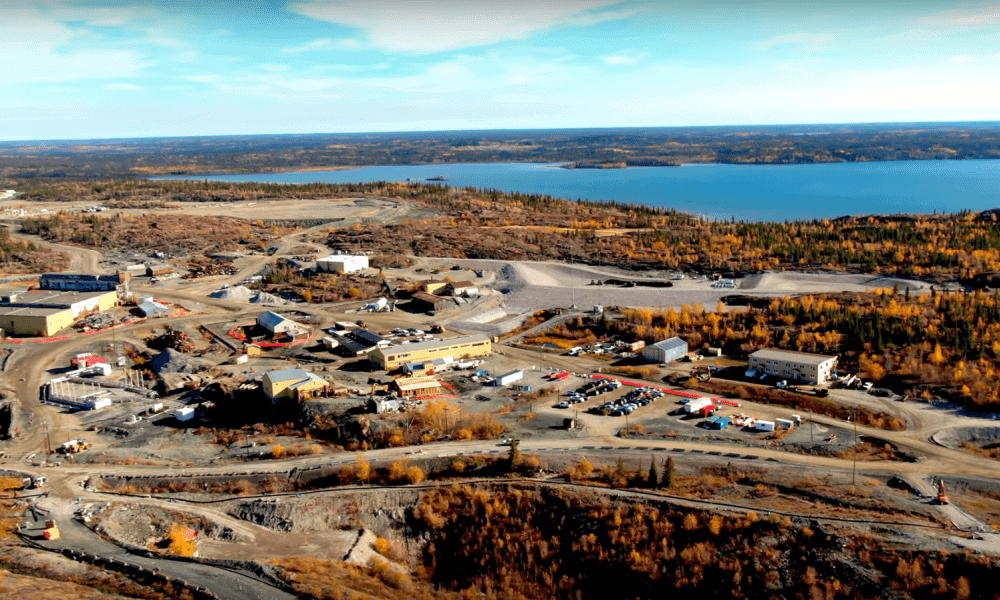
[Image above] Aerial view of the Giant Mine site located just north of Yellowknife, Northwest Territories, Canada. In the background is Yellowknife Bay, which is a small arm of Great Slave Lake, the tenth-largest lake in the world by area. Credit: Giant Mine Oversight Board, YouTube
Radioactive waste is a main concern that people have about relying on nuclear energy. Yet in some ways, this waste is not as concerning as the waste generated through other industrial processes, for example, mining.
“This dust [arsenic trioxide] is arguably worse than radioactive waste. There is no half-life here. It won’t decay over time. The dust will be just as deadly in 10,000, 100,000, or a million years,” British YouTuber Tom Scott says in a video on the arsenic waste at Giant Mine.
Giant Mine is a closed gold mine located just north of Yellowknife, Northwest Territories, Canada. Gold was first found on the site in 1935, but a commercial ore body was not confirmed until 1944; the first gold brick was poured in 1948.
The gold at Giant Mine occurred within an arsenic-rich mineral called arsenopyrite. Separating the gold from the arsenopyrite required roasting the ore at extremely high temperatures, which produced arsenic trioxide as a byproduct.
During the mine’s first few years of operation, the arsenic trioxide was released directly into the environment from a tall smokestack. But growing environmental and health concerns from the local Yellowknife community led mine operators to adapt their processes to capture the toxic dust and store it underground.
By the time the mine closed in 2004, roughly 237,000 tonnes of arsenic trioxide dust had been stored in 14 underground chambers. Yet because Royal Oak Mines, the last operator of the mine, declared bankruptcy in 1999, the Canadian government became responsible for cleaning up the Giant Mine site.
Moving the dust risks additional contamination of the surrounding environment. So, the government currently is freezing the dust in place, which keeps water from seeping into the underground chambers and carrying the arsenic out. The video below describes this freezing process.
(The mine operators also planned to freeze the dust in place by relying on the natural permafrost layer. But they exposed the permafrost by mining the rock above it, causing it to melt. Now, man-made methods are needed to keep the dust frozen.)

Credit: Tom Scott, YouTube
In 2015, the Giant Mine Oversight Board (GMOB) was established to monitor the remediation of the Giant Mine site. GMOB is an independent body comprised of members from the Canadian government, the government of the Northwest Territories, the Yellowknives Dene First Nation, the North Slave Métis Alliance, the social justice coalition Alternatives North, and the City of Yellowknife.
As part of the remediation effort, which is expected to cost $4.38 billion Canadian dollars, the GMOB partnered with researchers from across the country to explore potential permanent solutions for the arsenic trioxide. The currently running research programs include chemically changing the dust into a less toxic and less dissolvable chemical, mixing it into cement, and transforming it into glass (vitrification).
Vitrification is a technique widely used in the nuclear industry for handling radioactive waste. To use this technique for mine waste, a CBC article states that a GMOD-commissioned study is making three types of glass containing arsenic trioxide at rates of 5, 10, and 15%. These samples are then crushed and exposed to water to simulate 100 years of the waste being below ground.
While no results from the study are yet publicly available, the CBC article states that Ben Nind, the executive director of the GMOB, said he expects the first results to be published this year or in 2024.
If you have a research idea that could be part of a permanent solution for the management of the arsenic trioxide dust, GMOB requests that you reach out to them at ed@gmob.ca.
Author
Lisa McDonald
CTT Categories
- Environment


